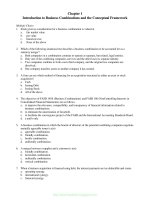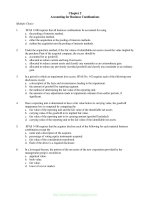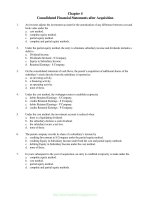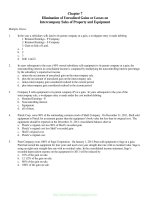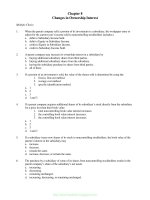advanced accounting 6e by jeter chaney chapter 01
Bạn đang xem bản rút gọn của tài liệu. Xem và tải ngay bản đầy đủ của tài liệu tại đây (825.76 KB, 52 trang )
Advanced
Accounting
Jeter ● Chaney
Introduction to Business
Combinations and the
Conceptual Framework
1
Prepared by Sheila Ammons, Austin Community College
Learning Objectives
• Describe historical trends in types of business
combinations.
• Identify the major reasons firms combine.
• Identify the factors that managers should consider in
exercising due diligence in business combinations.
• Identify defensive tactics used to attempt to block
business combinations.
• Distinguish between an asset and a stock acquisition.
Copyright © 2015. John Wiley & Sons, Inc. All rights reserved.
Learning Objectives (continued)
• Indicate the factors used to determine the price and the method of
payment for a business combination.
• Calculate an estimate of the value of goodwill to be included in an
offering price by discounting expected future excess earnings over
some period of years.
• Describe the two alternative views of consolidated financial statements:
the economic entity and the parent company concepts.
• Discuss the Statements of Financial Accounting Concepts (SFAC).
• Describe some of the current joint projects of the FASB and the
International Accounting Standards Board (IASB), and their primary
objectives.
Copyright © 2015. John Wiley & Sons, Inc. All rights reserved.
Introduction
• On December 4, 2007, FASB released two new standards,
– FASB Statement No. 141 R, Business Combinations, and
– FASB Statement No. 160, Noncontrolling Interests in Consolidated
Financial Statements.
• FASB ASC 805, “Business Combinations” and FASB ASC 810,
“Consolidations.
• These standards
– Became effective for years beginning after December 15, 2008, and
– Are intended to improve the relevance, comparability and transparency
of financial information related to business combinations, and to
facilitate the convergence with international standards.
Copyright © 2015. John Wiley & Sons, Inc. All rights reserved.
Nature of the Combination
Business Combination - operations of two or more
companies are brought under common control.
– A business combination may be:
• Friendly - the boards of directors of the potential
combining companies negotiate mutually agreeable
terms of a proposed combination.
• Unfriendly (hostile) - the board of directors of a
company targeted for acquisition resists the
combination.
Copyright © 2015. John Wiley & Sons, Inc. All rights reserved.
Nature of the Combination
Defensive Tactics
– Poison pill: Issuing stock rights to existing shareholders;
exercisable only in the event of a potential takeover.
– Greenmail: Purchasing shares held by the would-be acquiring
company at a price substantially in excess of fair value.
– White knight: Encouraging a third firm, more acceptable to the
target company management, to acquire or merge with the target
company.
LO 4 Defensive tactics are used
Copyright © 2015. John Wiley & Sons, Inc. All rights reserved.
Nature of the Combination
Defensive Tactics (continued)
– Pac-man defense: Attempting an unfriendly takeover
of the would-be acquiring company.
– Selling the crown jewels: Selling valuable assets to
make the firm less attractive to the would-be acquirer.
– Leveraged buyouts: Purchasing a controlling interest
in the target firm by its managers and third-party
investors, who usually incur substantial debt and
subsequently take the firm private.
LO 4 Defensive tactics are used.
Copyright © 2015. John Wiley & Sons, Inc. All rights reserved.
Nature of the Combination
Review Question
The defense tactic that involves purchasing shares held by the
would-be acquiring company at a price substantially in excess
of their fair value is called
a. poison pill.
b. pac-man defense.
c. greenmail.
d. white knight.
LO 4 Defensive tactics are used.
Copyright © 2015. John Wiley & Sons, Inc. All rights reserved.
Business Combinations: Why? Why
Not?
Advantages of External Expansion
– Rapid expansion
– Operating synergies
– International marketplace
– Financial synergy
– Diversification
– Divestitures
LO 2 Reasons firms combine.
Copyright © 2015. John Wiley & Sons, Inc. All rights reserved.
Business Combinations: Historical
Perspective
Three distinct periods:
– 1880 through 1904: Huge holding companies, or
trusts, were created to establish monopoly control
over certain industries (horizontal integration).
– 1905 through 1930: To bolster the war effort, the
government encouraged business combinations to
obtain greater standardization of materials and parts
and to discourage price competition (vertical
integration).
LO 1 Historical trends in types of M&A.
Copyright © 2015. John Wiley & Sons, Inc. All rights reserved.
Business Combinations: Historical
Perspective
Three distinct periods (continued)
1945 to the present:
– This period started after World War II and has exhibited rapid
growth in merger activity since the mid-1960s.
– There was even more rapid growth since the 1980s.
– By 1996, the number of yearly mergers completed was nearly
7,000, giving rise to the term merger mania.
– Most agreed that the mania had ending by mid-2002.
– By 2006, merger activity was soaring once more.
LO 1 Historical trends in types of M&A.
Copyright © 2015. John Wiley & Sons, Inc. All rights reserved.
Business Combinations: Historical
Perspective
Three distinct periods (continued):
1945 to the present: Many of the mergers that occurred from the 1950s
through the 1970s were conglomerate mergers.
• The primary motivation was often to diversify
business risk.
–In contrast, the 1980s were characterized by a relaxation in antitrust
enforcement and by the emergence of high-yield junk bonds to finance
acquisitions.
• Deregulation undoubtedly played a role in the popularity of
combinations in the 1990s.
LO 1 Historical trends in types of M&A.
Copyright © 2015. John Wiley & Sons, Inc. All rights reserved.
Terminology and Types of
Combinations
What Is Acquired?
Net assets of S Company
(Assets and Liabilities)
Common Stock
of S Company
What Is Given Up?
1.Cash
Illustration 1-3
2.
Debt
3.
Stock
5.Combination of Above
• Asset acquisition, a firm must acquire 100% of the assets of the other firm.
• Stock acquisition, control may be obtained by purchasing 50% or more of the
voting common stock (or possibly less).
LO 5 Stock versus asset acquisitions.
Copyright © 2015. John Wiley & Sons, Inc. All rights reserved.
Terminology and Types of
Combinations
Possible Advantages of Stock Acquisition
– Lower total cost in many cases.
– Direct formal negotiations with the acquired firm’s management
may be avoided.
– Maintaining the acquired firm as a separate legal entity.
– Liability limited to the assets of the individual corporation.
– Greater flexibility in filing individual or consolidated tax returns.
– Regulations pertaining to one of the firms do not automatically
extend to the entire merged entity.
LO 5 Stock versus asset acquisition.
Copyright © 2015. John Wiley & Sons, Inc. All rights reserved.
Terminology and Types of
Combinations
Classification by Method of Acquisition
Statutory Merger
A Company
+
B Company
=
A Company
One company acquires all the net assets of another company.
The acquiring company survives, whereas the acquired company
ceases to exist as a separate legal entity.
LO 5 Stock versus asset acquisitions.
Copyright © 2015. John Wiley & Sons, Inc. All rights reserved.
Terminology and Types of
Combinations
Classification by Method of Acquisition
Statutory Consolidation
A Company
+
B Company
=
C Company
A new corporation is formed to acquire two or more other corporations through
an exchange of voting stock; the acquired corporations then cease to exist as
separate legal entities.
Stockholders of the acquired companies (A and B) become stockholders in the
new entity (C).
LO 5 Stock versus asset acquisitions.
Copyright © 2015. John Wiley & Sons, Inc. All rights reserved.
Terminology and Types of
Combinations
Classification by Method of Acquisition
Consolidated Financial Statements
Financial
Statements of A
Company
+
Financial
Statements of B
Company
=
Consolidated
Financial
Statements of A
Company and B
Company
When a company acquires a controlling interest in the voting stock of
another company, a parent–subsidiary relationship results.
LO 5 Stock versus asset acquisitions.
Copyright © 2015. John Wiley & Sons, Inc. All rights reserved.
Terminology and Types of
Combinations
Review Question
When a new corporation is formed to acquire two or more
other corporations and the acquired corporations cease to
exist as separate legal entities, the result is a statutory
a. acquisition.
b.consolidation.
c. combination.
d.merger
LO 5 Stock versus asset acquisitions.
Copyright © 2015. John Wiley & Sons, Inc. All rights reserved.
Takeover Premiums
Takeover Premium – the excess amount offered, or agreed upon, in an
acquisition over the prior stock price of the acquired firm.
Possible reasons for the premiums:
– Acquirers’ stock prices may be at a level which makes it attractive to
issue stock (rather than cash) in the acquisition.
– Credit may be generous for mergers and acquisitions.
– Bidders may believe target firm is worth more than its current market
value or has assets not reported on the balance sheet.
– Acquirer may believe growth by acquisitions is essential and competition
necessitates a premium.
LO 5 Stock versus asset acquisitions.
Copyright © 2015. John Wiley & Sons, Inc. All rights reserved.
Avoiding the Pitfalls Before the
Deal
Beware of the following factors:
– Be cautious in interpreting any percentages.
– Do not neglect to include assumed liabilities in the assessment of the
cost of the merger.
– Watch out for the impact on earnings of the allocation of expenses and
the effects of production increases, standard cost variances, LIFO
liquidations, and byproduct sales.
– Note any nonrecurring items that may have artificially or temporarily
boosted earnings.
– Look for recent changes in estimates, accrual levels, and methods.
– Be careful of CEO egos.
LO 3 Factors to be considered in due diligence.
Copyright © 2015. John Wiley & Sons, Inc. All rights reserved.
Avoiding the Pitfalls Before the
Deal
Review Question
When an acquiring company exercises due diligence in
attempting a business combination, it should:
a. be skeptical about accepting the target company’s stated
percentages
b.analyze the target company for assumed liabilities as well
as assets
c. look for nonrecurring items such as changes in estimates
d.all the above
LO 3 Factors to be considered in due diligence.
Copyright © 2015. John Wiley & Sons, Inc. All rights reserved.
Determining Price and Method of Payment in Business Combinations
When a business combination is effected by a stock swap,
or exchange of securities, both price and method of
payment problems arise.
– The price is expressed as a stock exchange ratio
(generally defined as the number of shares of the
acquiring company to be exchanged for each share of
the acquired company).
– Each constituent makes two kinds of contributions to
the new entity—net assets and future earnings.
LO 6 Factors affecting price and method of payment.
Copyright © 2015. John Wiley & Sons, Inc. All rights reserved.
Determining Price and Method of Payment in Business Combinations
Net Asset and Future Earnings Contributions
• Determination of an equitable price for each constituent
company requires:
– The valuation of each company’s
• net assets and
• expected contribution to the future earnings of the
new entity.
LO 6 Factors affecting price and method of payment.
Copyright © 2015. John Wiley & Sons, Inc. All rights reserved.
Determining Price and Method of
Payment
Excess Earnings Approach to Estimate Goodwill
– Step 1:Identify a normal rate of return on assets for firms
similar to the company being targeted.
– Step 2: Apply the rate of return (step 1) to the net assets of the
target to approximate “normal earnings”.
– Step 3: Estimate the expected future earnings of the target.
Exclude any nonrecurring gains or losses.
– Step 4: Subtract the normal earnings (step 2) from the expected
target earnings (step 3). The difference is “excess earnings”.
LO 6 Factors affecting price and method of payment.
Copyright © 2015. John Wiley & Sons, Inc. All rights reserved.
Determining Price and Method of
Payment
Excess Earnings Approach to Estimate Goodwill (continued)
• Step 5: Compute estimated goodwill from “excess earnings”.
– If the excess earnings are expected to last indefinitely, the present value
may be calculated by dividing the excess earnings by the discount rate.
– For finite time periods, compute the present value of an annuity.
• Step 6: Add the estimated goodwill (step 5) to the fair value of the firm’s net
identifiable assets to arrive at a possible offering price.
LO 6 Factors affecting price and method of payment.
Copyright © 2015. John Wiley & Sons, Inc. All rights reserved.


